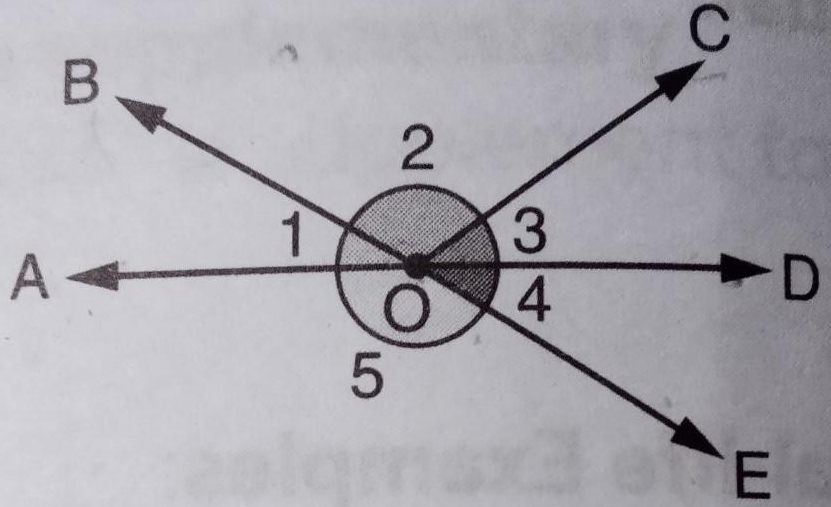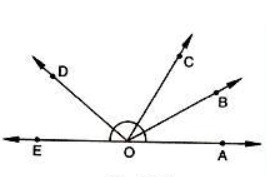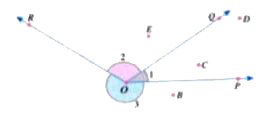How many pairs of adjacent angles are formed when two lines intersect at a point?
To solve the question of how many pairs of adjacent angles are formed when two lines intersect at a point, we can follow these steps:
1. Understanding the Intersection of Lines:
When two lines intersect, they create an 'X' shape. Let's denote the two lines as line AB and line CD, which intersect at point O.
2. Identifying the Angles:
When lines AB and CD intersect at point O, they form four angles. We can label these angles as follows:
- Angle AOD
- Angle DOB
- Angle COB
- Angle COA
3. Identifying Adjacent Angles:
Adjacent angles are angles that share a common side and a common vertex. In our case, the angles formed at point O can be paired as follows:
- Angle AOD and Angle DOB (pair 1)
- Angle DOB and Angle COB (pair 2)
- Angle COB and Angle COA (pair 3)
- Angle COA and Angle AOD (pair 4)
4. Counting the Pairs:
From the pairs identified, we see that there are a total of 4 pairs of adjacent angles formed by the intersection of the two lines.
5. Conclusion:
Therefore, the answer to the question is that 4 pairs of adjacent angles are formed when two lines intersect at a point.
Final Answer:
There are 4 pairs of adjacent angles formed when two lines intersect at a point.
---
When two lines intersect, they create an 'X' shape. Let's denote the two lines as line AB and line CD, which intersect at point O.
When lines AB and CD intersect at point O, they form four angles. We can label these angles as follows:
- Angle AOD
- Angle DOB
- Angle COB
- Angle COA
Adjacent angles are angles that share a common side and a common vertex. In our case, the angles formed at point O can be paired as follows:
- Angle AOD and Angle DOB (pair 1)
- Angle DOB and Angle COB (pair 2)
- Angle COB and Angle COA (pair 3)
- Angle COA and Angle AOD (pair 4)
From the pairs identified, we see that there are a total of 4 pairs of adjacent angles formed by the intersection of the two lines.
Therefore, the answer to the question is that 4 pairs of adjacent angles are formed when two lines intersect at a point.
There are 4 pairs of adjacent angles formed when two lines intersect at a point.
Topper's Solved these Questions
Similar Questions
How many pairs of adjacent angles are formed when two lines intersect in a point?
View SolutionWrite five pairs of adjacent angles.

View SolutionHow many pairs of adjacent angles, in all, can you name in Figure.
View SolutionHow many pairs of adjacent angles, in all, can you name in Figure?
 View Solution
View SolutionIn Figure, ABCD is a quadrilateral. Name a pair of adjacent sides. Name a pair of opposite sides. How many pairs of adjacent sides are there? How many pairs of opposite sides are there? Name a pair of adjacent angles. Name a pair of opposite angles. How many pairs of adjacent angles are there? How many pairs of opposite angles are there?
View SolutionIn Figure, write all pairs of adjacent angles and all the linear pairs.
View SolutionAnswer the following from the figure given alongside.
 .
.
a. Name ∠POQ in two more ways.
b. Name all the pairs of adjacent angles.
c. Name the points in the interior of ∠1.
d. Name the points in the exterior of ∠1.
e. Name the points on ∠1.View SolutionIn parallelogram ABCD, the bisectors of adjacent angles A and D intersect each other at point P. prove that ∠APD=90∘.
View SolutionHow many angles are formed in the figures. Name them.
View SolutionFill in the blanks:(i) If two angles are complementary, then the sum of their measures is _______.(ii) If two angles are supplementary, then the sum of their measures is ______.(iii) Two angles forming a linear pair are _______________.(iv) If two adjacent angles are supplementary, they form a ___________.(v) If two lines intersect at a point, then the vertically opposite angles are always_____________.(vi) If two lines intersect at a point, and if one pair of vertically opposite angles areacute angles, then the other pair of vertically opposite angles are __________.
View Solution

